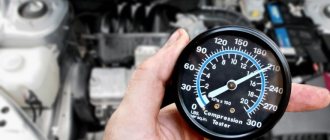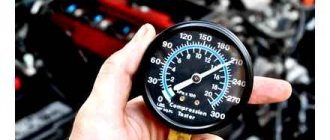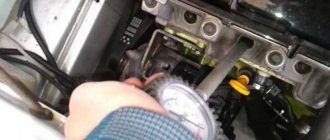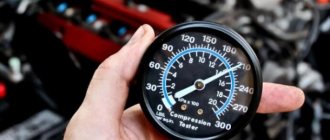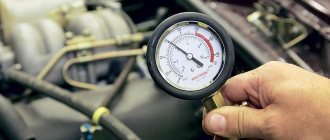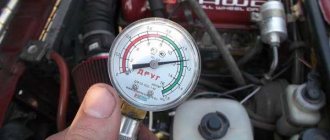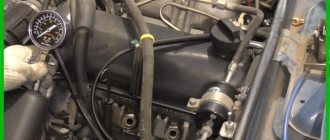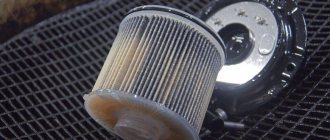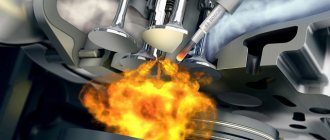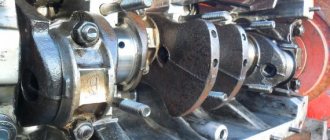Engine compression
Engine compression indicates the condition of the engine, its service life, power, and torque. This procedure must be performed every 20-30 thousand kilometers, as well as before purchasing a car. Even when checking at a service center, YOU will need knowledge of “how to correctly measure compression”, because... Servicemen love to deceive and make money from you. Let's start with the theory: Compression is the pressure created in the cylinder at the end of the compression stroke. Another term is appropriate here: Engine compression ratio. The engine compression ratio is expressed in the following ratio: compression/combustion chamber volume.
What compression should be in the cylinders of a VAZ engine?
Normal engine compression is at least 10 bar (1.0 MPa), and the difference between the cylinders should not exceed 1 bar (0.1 MPa). If your compression is 11-12-11-12 from cylinders 1 to 4, then the engine is fine, but do not forget to adjust the valves every 2500 km. If you have 11-9-12-11, then you need to look for the reason and make repairs, because Driving in such conditions will only kill the engine.
How much should the ideal compression be? The ideal compression should be 14 bar for an 8-valve engine in each cylinder with minimal variation (14-14-14-14).
conclusions
It was found that normal compression for a VAZ-2114 engine is 11-14 bar . An increase or decrease in this indicator, as well as a gap of more than 1 bar between the cylinders, is not considered normal and is subject to diagnosis. Engine compression is measured using a compression gauge.
There are several inaccuracies. Firstly, compression is traditionally measured with the engine not running at the starting speed generated by the starter! This is important: the pressure at the end of the compression stroke depends on the crankshaft speed, so if the engine is running, the compression will be much higher than the specified range - up to several times! Secondly, compression is measured on a warm engine (although there are some “former” ones who measure it on a cold engine, but the result is no more than a “funny letter”!). Third, the throttle must be fully open. Otherwise, the required amount of air will not be supplied, so the readings will be underestimated (there is nothing to compress!). On an injection engine, when the throttle valve is fully opened, the fuel supply and sparking stop (so-called cylinder purging). So there is no need to additionally turn off the ignition system (unlike carburetor engines). Fourthly, not only the absolute value of the pressure itself is important, but also how quickly it builds up. This indicator characterizes the condition no less accurately than the pressure itself. Ideally, a fixed value should be achieved in 2-3 “pumps”. And fifthly, the compression level is also affected by the condition of the starter and the flywheel ring gear: if the teeth are worn out and jammed, the compression value will also be underestimated. In general, for a more accurate assessment of the condition, the leak method is now much more often used.
How to measure engine compression?
To check the compression we need a spark plug wrench, a charged battery and a compression gauge. You also can’t do without an assistant.
- Warm up the engine to operating temperature.
- We turn out all the candles.
- We install a device for measuring compression (compressometer) into the spark plug hole that appears.
- The assistant presses the gas all the way and starts the car within 6-10 seconds.
- We remember the compression gauge readings and carry out similar operations on the remaining cylinders.
Taking measurements
The pressure must be measured on a warm engine using a special pressure gauge - a compression gauge. The devices are of clamping and threaded type. The first ones must be pressed by hand, the second ones are screwed alternately into each cylinder. Measurements are made as follows:
- disconnect and remove the high voltage wires, remove the spark plugs;
- insert or screw the working part of the compression gauge into the spark plug socket;
- press the gas pedal and turn the crankshaft several times with the starter.
Repeat the operation on each cylinder in turn. If the device is of a clamping type, then the services of an assistant will be required for measurements. While you press the pressure gauge firmly against the hole, an assistant should press the accelerator pedal and start the starter. Having received the results, you can proceed to analysis.
Low and different compression in the engine, what to do?
If, after checking the compression, the compression meter shows below 10 bar in at least one cylinder, then you urgently need to find out the cause and fix the problem, otherwise you risk losing compression in the remaining cylinders.
If, for example, you do not have sufficient compression in 1.4 and any other cylinder:
- We fill a medical syringe with about 10 cubic centimeters of motor oil.
- Spray oil into the hole that appears.
- We measure the compression again.
If, after re-measuring, the compression has increased, it means the rings are worn out. If the result remains the same, it means the valves are burnt out or jammed. Stiff valves can be adjusted, and burnt valves can be replaced.
Why check
It is recommended to check the compression on the VAZ 2110 regularly to prevent possible malfunctions and problems with the engine. Measurements are taken with the throttle valve open and closed. Each test option gives its own results and data on the condition of the engine.
Checking with the valve open allows you to determine:
- Problems and damage on cylinder surfaces;
- Deformation, burnout of valves;
- Sticking or coking of piston rings.
If you check the compression with the throttle closed, you can find out:
High compression in the engine. Main reasons.
Don't be too happy if your compression readings are off the charts, this is in no way indicative of how cool your engine is. As stated above, the ideal compression for an 8-valve engine is 14-14-14-14. If your compression is higher than these numbers, then it’s time to think about malfunctions. High compression can damage the partitions of the pistons and tear the cylinders. Below are the main reasons for high/high compression: High compression is created due to excess oil in the cylinder, which is why it is sometimes also called “oil compression”.
- The valve stem seals (VSC) have worn out and died.
- The oil scraper rings are worn out or stuck. (In such cases, oil consumption is inevitable. Check the oil level: How to check the oil level in the engine? Also pay attention to starting the engine after a long stop, for example, in the morning. If the engine oil is consumed, the exhaust will be black).
- There may be carbon deposits in the cylinders. Try to get rid of it by decoking.
Factors influencing compression of internal combustion engines
Compression in an engine is the pressure generated in the cylinder as the piston moves from BDC to TDC.
Normal compression in a VAZ 2114 engine
Compression is affected by many different factors.
- The pressure inside the volume is determined by the amount of gas entering. In an internal combustion engine, this is influenced by the throttle valve and the air filter capacity. Therefore, it is so important to promptly change a clogged filter element.
- During adjustment or repair work, car mechanics may make inaccuracies in setting the valve timing. As a result, the closing timing of the intake valve changes. The cycle is disrupted and this leads to a change in pressure in the cylinders.
- Incorrect adjustment of the clearances in the valve drive also leads to deviations in compression from the maximum effective one.
- Engine power, which directly depends on the degree of compression in the cylinders, is affected by the temperature of the internal combustion engine. If for some reason it is significantly lower than the established working value, then the compression in the cylinders will be less and, accordingly, the power will decrease.
- Due to burnout of valves and cylinder walls, worn-out rings, and some other mechanical damage to the piston group, mixture leaks from the cylinder during the compression stroke. As a result, compression is reduced.
- For some reason, excess fuel enters the cylinder, gasoline settles on the inner walls and washes away oil from them, reducing the seal, and leading to additional air leaks, as well as a decrease in the power of the power unit.
In its turn:
- the correct oil layer on the cylinder walls leads to sealing of gaps and reduction of leaks;
- an increase in engine temperature heats up the parts, the metal of which expands and they fit closer together, preventing the formation of unnecessary gaps, as a result the engine power increases;
- the higher the crankshaft speed, the sharper the piston movement and the more efficient the compression occurs, this also increases the pressure in the cylinder and, accordingly, the engine power.
Signs of poor compression
If you encounter the problems outlined below, then it is possible, BUT FAR FAR from a fact, that your engine has insufficient compression. Therefore, you don’t need to pay attention to the signs, but you just need to measure the compression.
- Misfires.
- Troit.
- Low dynamics.
- Engine knock.
- There is oil.
- Black smoke.
- Poor cold start.
- High fuel consumption (Causes of high fuel consumption on VAZ).
WHAT TO DO IF YOU DO NOT HAVE A COMPRESSOMETER AT HAND?
Is it possible to measure compression without a device? Practice shows that yes, it is possible. But this method will give relative and approximate readings. To measure the compression indicator without instruments, remove the spark plugs from all cylinders except the one being tested. Manually rotate the crankshaft until the compression stroke ends (watch the marks - they should match). Perform this operation on all cylinders one by one. Where the pressure is low, it will take less effort to turn the crankshaft. In this way, of course, you will not get accurate compression readings in the engine. But it is possible to understand the presence of problems.
It is recommended to measure compression every 20-30 thousand kilometers, so every car enthusiast is recommended to have his own compression gauge. Its price is not so high that it is worth saving on it.
The approximate price of a device for measuring engine compression in online stores in the capital is from 600 rubles to 2 thousand. Branded models from Western manufacturers are more expensive – up to 8 thousand. In the regions, a device for measuring compression costs no more than in the capital. Its price varies depending on the manufacturer.
How to increase engine compression in other ways?
There are several options for raising compression without repair. These operations do not in any way guarantee an increase in compression, but you can try. But it is still recommended to eliminate the malfunction by mechanical action - eliminate the malfunction: replace the rings or replace the valves.
- Adjustment of valves. I tried it myself, it really works. The valve could be jammed and therefore not close, resulting in a compression leak.
- Roscoking – removes carbon deposits and excess oil in the cylinder. It only helps with stuck rings; if the valves are burnt out, there is no point in carrying out this operation.
How often should I check my blood pressure?
For preventive purposes, diagnostics should be carried out along with replacing the spark plugs of a gasoline engine. Depending on the brand of car, technical condition and quality of products, such an operation is carried out at intervals of 25–50 thousand km.
The following symptoms are the reason for an emergency compression check:
- the power unit began to “eat” oil in the amount of 150 ml per 1 thousand km or more;
- blue smoke from the exhaust tract is noticeable;
- the car became bad;
- At idle the engine stalls and shakes.
The last sign may indicate a malfunction of the ignition system or failure of 1-2 spark plugs. Before measuring pressure, it is advisable to eliminate such problems. On diesel engines, wear of the piston group and valves manifests itself in similar symptoms; cold starts are especially difficult - if there is insufficient pressure, the diesel fuel simply does not flare up.
Compression measurement: without a compression meter or using special equipment
So, in practice, only two methods are actively used that allow compression measurements to be taken:
- using a compression gauge;
- compression measurement by hand;
Naturally, the presence of a device allows you to obtain the most accurate readings, however, in emergency cases or to obtain approximate estimated results, the decision to measure compression manually is also practiced.
Let us immediately note that in order to measure compression without instruments, certain skills and knowledge will be required, and the operation does not present any great difficulties, even for novice car enthusiasts.
- First you need to unscrew the spark plugs, leaving only the spark plug in the first cylinder.
- Then the crankshaft must be turned so that the piston in the first cylinder is at the end of the compression stroke.
- To accurately determine that the piston is in the correct position, you need to check the marks.
- Next, you should approximately remember with what force the crankshaft was turned by hand.
- After this, the spark plug is screwed into the second cylinder and so on.
Note that although the method is quite primitive, in some cases even it allows you to get a general idea and identify a problem in a particular engine cylinder. More accurate measurements can only be made using a compression gauge.
- First of all, you need to study the technical documentation in relation to the specific type of internal combustion engine installed on the machine.
- Having determined the specific compression value for the engine, you need to start the engine and warm it up until it reaches operating temperature (the cooling fan turns on).
- Then the spark plugs are carefully unscrewed. Next, you need to invite an assistant who will depress the gas pedal (an important condition when measuring compression) and crank the engine with the starter.
- If we talk about the device, the compression gauge has a special tip that is tightly inserted into the spark plug hole.
- After this, the engine is cranked by the starter for about 3-4 seconds. It is also important to take into account that you need to measure compression provided that the battery is charged and the starter itself is fully operational. The fact is that insufficient crankshaft rotation speed can lead to a noticeable decrease in performance, but this will not mean that the compression in the engine has dropped so much.
- Then, when the readings have been obtained, they need to be compared with the nominal values for a particular engine.
It is also important to understand that it is not recommended to continue operating an engine in which compression is reduced in one or more cylinders for a long time. The fact is that the parts in this cylinder will wear out even more, the engine itself will vibrate more strongly and operate unstably, unburned fuel will flow into the oil pan in excess, which will cause dilution of the oil, thereby increasing the overall wear of the internal combustion engine, etc.
Causes of malfunction
There are a number of reasons why the required compression level may fall below established standards. Therefore, before checking the pressure and carrying out repairs, you should understand the possible causes of the problem.
- The cylinder block gasket has burnt out;
- Burnt out pistons or valves;
- The cylinder-piston group has worn out;
- Valve seats have collapsed;
- A crack has formed in the exhaust valve disc.
The manufacturer indicates the normal compression level and compression ratio for each engine. At the same time, these characteristics are confused, considering them one of the same. The compression ratio is the ratio of the total volume of the cylinder to the volume of the combustion chamber.
To calculate the optimal compression ratio for an engine, use the formula:
Compression = Compression Ratio * K Factor.
In the case of gasoline engines, the coefficient is 1.2, while for diesel versions it is 1.8.
